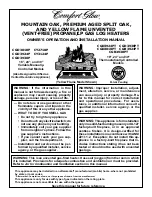
6
foot of air. Therefore, the heater input rate should be reduced at high
altitudes for satisfactory operation with the reduced oxygen supply.
Failure to make this reduction would result in an over-firing of the
heater causing sooting, poor combustion and/or unsatisfactory heater
performance.
Ratings specified by manufacturers for most appliances apply for
elevations up to 2000 feet (610 m). For elevations above 2000 feet
(610), ratings must be reduced at the rate of 4% for each 1000 feet
(305m) above sea level. For example, if a heater is rated at 120,000
Btuh (35 Kwh) at sea level, to rate the heater at 4000 feet (1219 m),
you subtract 4 (once for each thousand feet) x 04 (4% input reduction)
x 120,000 (original rating) from the original rating. Therefore, to
calculate the input rating at 4,000 feet (121.9 m): 4 x .04 x 120,000 =
19,200 Btuh (5.6 Kwh), 120,000 (35 Kwh) - 19,200 (5.6 Kwh) = 100,800
Btuh (29.4 Kwh). At 6000 feet (1829 m) the correct input rating should
be 91,200 Btuh (26.7 Kwh).
Field conversion is not permitted.
FEATURES
THE ELIMINATOR
(SELF-CLEANING SYSTEM)
These units include The Eliminator (Self-Cleaning System) installed in
the front water inlet, see Figure 2. The Eliminator must be oriented
correctly for proper function. There is a marked range on the pipe
nipple portion of the Eliminator, that must be aligned with the top of the
inlet spud. A label above the jacket hole has an arrow that will point to
the marked portion of the pipe nipple if the orientation is correct. If the
arrow does not point within the marked range on the pipe nipple,
adjust the pipe nipple to correct. A pipe union is supplied with the
Eliminator to reduce the probability of misaligning the Eliminator
accidentally while tightening the connection to the inlet water supply
line. Improper orientation of the Eliminator can cause poor performance
of the heater and can significantly reduce outlet water temperatures
during heavy draws.
FIGURE 1
HIGH LIMIT SWITCH (E.C.O.)
The dual bulb controller contains the high limit (energy cutoff) sensor,
see Figure 2. The high limit switch interrupts main burner gas flow
should the water temperature reach 205°F (96°C).
In the event of high limit switch operation, the appliance cannot be
restarted unless the water temperature is reduced by at least 20°F
(11°C) and the high limit reset button on front of limit control is depressed,
see Figure 2.
Continued manual resetting of high limit control, preceded by higher
than usual water temperature is evidence of high limit switch operation.
The following is a possible reason for high limit switch operation.
•
A malfunction in the thermostatic controls could allow the gas valve
to
r e m a i n o p e n c a u s i n g w a t e r t e m p e r a t u r e t o e x c e e d t h e
thermostat setting. The water temperature would continue to rise
until high limit switch operation.
Contact your dealer or servicer if continued high limit switch operation
occurs.
DUAL-BULB THERMOSTAT
(SHOWN AT TOP WITH COVER ON AND AT BOTTOM
WITH COVER REMOVED)
FIGURE 2
Continued pilot outage preceded by higher than usual water temperature
is evidence of high limit switch operation. Contact your dealer or
servicer to determine the reason for operation.
CIRCULATING PUMP
A circulating pump is used when a system requires a circulating
loop or there is a storage tank used in conjunction with the heater.
Refer to the piping diagrams in this manual for electrical hookup
information and install in accordance with the current version of
the National Electric Code ANSI/NFPA No. 70.
Only all bronze circulators are used with commercial water heaters.
Although circulators are oiled and operated by the manufacturer some
circulators must be oiled again before operating. Please refer to
manufacturer’s instructions.
DISHWASHING MACHINE REQUIREMENT
These appliances meet the National Sanitation Foundation Standard for
sanitary installations when used with the following leg kits, Part No’s.
6570-0 and 6570-7.
All dishwashing machines meeting the National Sanitation Foundation
requirements are designed to operate with water flow pressures







































